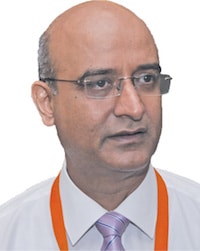Engineers and researchers require a platform to simulate and do predictive analysis of their design before implementing it into real-world applications. Sunil Motwani, industry director, MathWorks, discusses model-based design through MATLAB and Simulink with Deepshikha Shukla of Electronics For You

Q. How does MathWorks support engineers and researchers?
A. MathWorks helps them accelerate their pace of innovation. MATLAB and Simulink are our two core platforms. These help create algorithms and mathematical models for applications that can be deployed on desktops, servers, cloud or in embedded systems.
MathWorks platforms provide from basic to complex Maths functions, to building blocks of physical systems, such as electrical, hydraulic and mechanical. These platforms are used to develop multi-domain systems, including mechanical, control and power sub-systems. As an example, one can model and deploy an embedded control system for advanced driver assistance.
Q. What is the difference between MATLAB and Simulink?
A. MATLAB is an high-level, interpreted programming language that provides an interface to users to write commands and get results as they explore ideas. It has high-level functions and tools to support designing of systems, such as signal processing, control, image processing and computer vision.
Simulink provides an environment to model the system in the form of a block diagram. It provides blocks for different Maths functions. By connecting the blocks, users can create a system.
Behind the blocks, there are ordinary differential equation solvers that help simulate the system. After creating a block diagram, they can simply press Run to give input to the system and visualise the output, to understand whether the system is behaving as expected or not.
Q. How do MATLAB and Simulink work together?
A. The two combine textual and graphical programming to design a system in a simulation environment. MATLAB is the language for technical computing and Simulink supports model-based design, which is used for multi-domain simulation, automatic code generation, and test and verification of embedded systems design.
Code generated from MATLAB/Simulink is production-ready, so users can directly deploy this on embedded devices, cloud or enterprise systems, and integrate with data sources and business systems.
There are thousands of algorithms/functions available in MATLAB to use directly. Same algorithms/functions are available as Simulink blocks.
Q. How do artificial intelligence (AI) and machine learning (ML) help in predictive analysis?
A. MATLAB is a platform to build data analytics algorithms which is the core of AI. Whereas, Simulink is a platform to build models of physical systems.
Users can build predictive analytics algorithms in MATLAB and train the algorithms using available failure data of physical systems. If failure data is not available from real systems, they can create synthetic data from Simulink model by modelling failure conditions.
Deep learning in AI uses multi-layer neural networks. For faster training of these multilayer networks, users may have to use the computing power of hardware like GPU.
MathWorks provides automatic GPU code generation technology using GPU coder that completes the workflow for generating GPU code from MATLAB/Simulink model.
Q. What is the role of a digital twin in model-based design?
A. It helps refine a model and simulate failure conditions. It also helps understand how the real asset will behave under certain conditions.
Q. Can users contribute to MATLAB’s library?
A. Yes, there is a user community forum called MATLAB Central. Several MATLAB and Simulink users have shared their work on it, which can be used by anyone.
Q. Does the software use any certification?
A. There are stringent compliance and certification standards that every code must go through before being deployed for safety-critical applications.
The workflow we support includes verification and validation at model and code levels. Depending on application, there are various levels of certification. MathWorks provides complete workflow—from modelling the requirements, creating.






